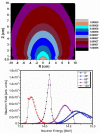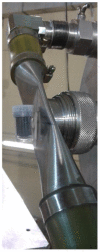14 MeV Neutrons for 99Mo/99mTc Production: Experiments, Simulations and Perspectives
- PMID: 30060449
- PMCID: PMC6222560
- DOI: 10.3390/molecules23081872
14 MeV Neutrons for 99Mo/99mTc Production: Experiments, Simulations and Perspectives
Abstract
Background: the gamma-emitting radionuclide Technetium-99m (99mTc) is still the workhorse of Single Photon Emission Computed Tomography (SPECT) as it is used worldwide for the diagnosis of a variety of phatological conditions. 99mTc is obtained from 99Mo/99mTc generators as pertechnetate ion, which is the ubiquitous starting material for the preparation of 99mTc radiopharmaceuticals. 99Mo in such generators is currently produced in nuclear fission reactors as a by-product of 235U fission. Here we investigated an alternative route for the production of 99Mo by irradiating a natural metallic molybdenum powder using a 14-MeV accelerator-driven neutron source.
Methods: after irradiation, an efficient isolation and purification of the final 99mTc-pertechnetate was carried out by means of solvent extraction. Monte Carlo simulations allowed reliable predictions of 99Mo production rates for a newly designed 14-MeV neutron source (New Sorgentina Fusion Source).
Results: in traceable metrological conditions, a level of radionuclidic purity consistent with accepted pharmaceutical quality standards, was achieved.
Conclusions: we showed that this source, featuring a nominal neutron emission rate of about 1015 s-1, may potentially supply an appreciable fraction of the current 99Mo global demand. This study highlights that a robust and viable solution, alternative to nuclear fission reactors, can be accomplished to secure the long-term supply of 99Mo.
Keywords: Molibdenum-99; Technetium-99m; neutron generator.
Conflict of interest statement
The authors declare no conflict of interest and declare that have not received funding, contracts or other forms of personal or institutional funding for this research.
Figures














References
-
- Bé M.M., Chisté V., Dulieu C., Browne E., Chechev V., Kuzmenk N., Helmer R., Nichols A., Schönfeld E., Dersch R. Table of Radionuclides, Monographie BIPM-5. Bureau International des Poids et Mesures; Sèvres, France: 2004. Vol. 1-A=1 to 150.
-
- [(accessed on 28 May 2018)]; Available online: http://www.nucleide.org/DDEP_WG/Nuclides/Tc-99m_tables.pdf.
-
- International Atomic Energy Agency . Non-HEU Production Technologies for Molybdenum-99 and Technetium-99m. IAEA; Vienna, Austria: 2013. (IAEA Nuclear Energy Series No. NF-T-5.4). Technical Reports.
-
- [(accessed on 28 May 2018)]; Available online: http://www.nucleide.org/DDEP_WG/Nuclides/Mo-99_tables.pdf.
-
- OECD Nuclear Energy Agency . NEA-OECD, Report on the Supply of Medical Radioisotopes: An Assessment of Long-Term Global Demand for Technesium-99m. OECD; Paris, France: 2011.
MeSH terms
Substances
LinkOut - more resources
Full Text Sources
Other Literature Sources

